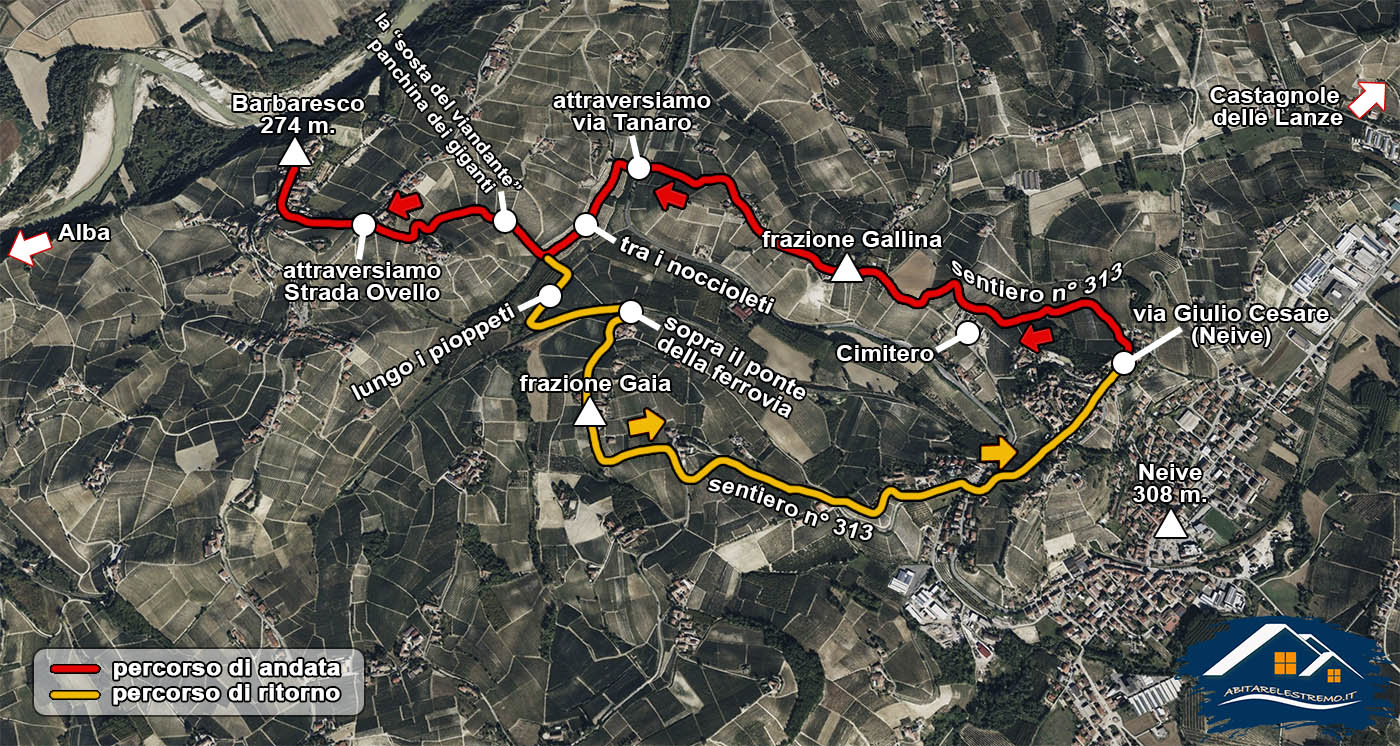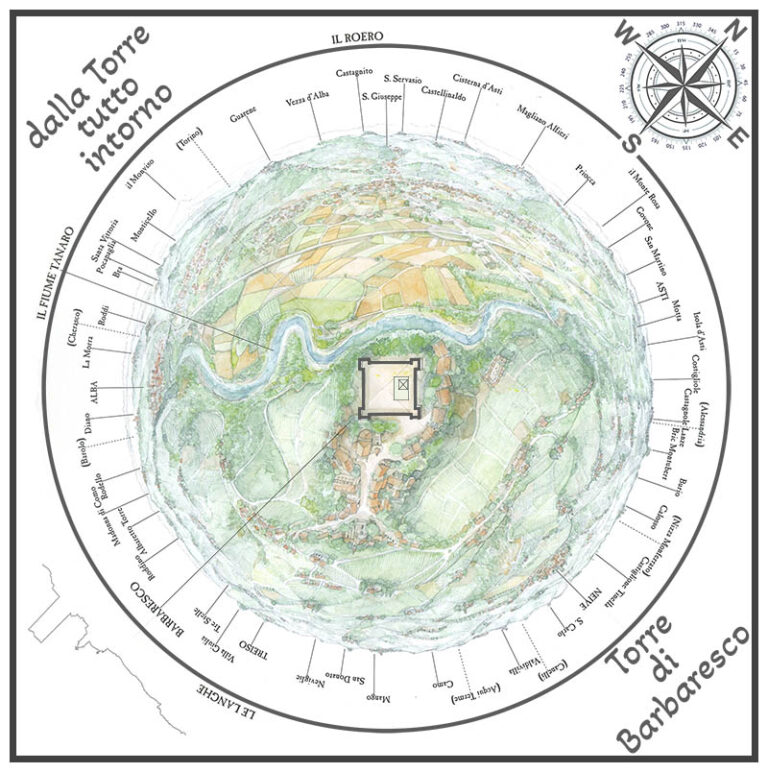Loop trail n° 313 Neive – Barbaresco – Neive (Italy – Langhe)
pleasant and relaxing trekking route that joins two historic villages in the area, enhanced by the fine environment,
the 360° open panorama, on the border between Langhe and Roero
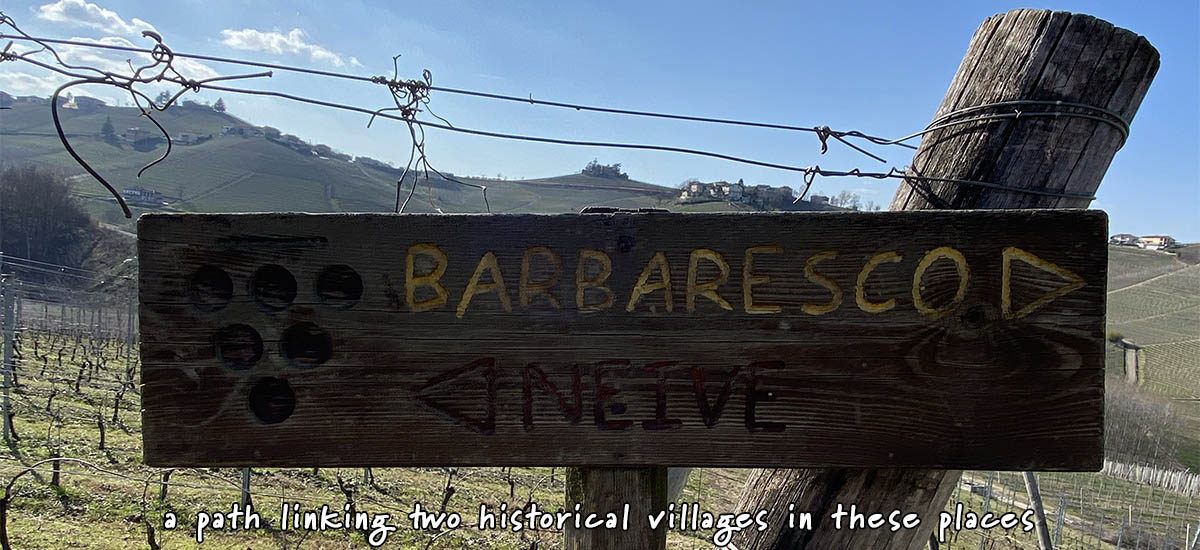
Starting location: Neive 308 m. (CN)
Intermediate locality: Barbaresco 274 m. (CN)
Arrival location: Neive 308 m.
Time required: 1h 45′ outward route and 1h 55′ return route
Timing that does not consider the stop in the area of the giants’ bench, the visit to the village of Barbaresco
and the climb up the tower
Elevation gain: about 150 m.
Signpost: n° 313
Difficulty level: E [level scale].
Period: all year round
Equipment required: classic hiking equipment
Waste: here’s what you need to know before abandoning it

Path No. 313, which unwinds through the hills and prestigious vineyards, not only offers great landscapes
but also joins two villages considered among the “most beautiful in Italy”: Neive and Barbaresco.
In Barbaresco, it is possible to climb the tower to appreciate a 360-degree view of the Roero, the Langhe,
the Tanaro River, the hills and crops, as well as the entire chain of the Alps, with Monviso towering sharply among
the endless mountains on the horizon.
A panorama that will give you an indelible memory of these areas that we are extensively describing and
documenting within our website.
Along the way we will reach a bench of giants and also today we will take you to experience an exclusive,
special and very pleasant loop tour.
Welcome or welcome back to the pages of abitarelestremo.it
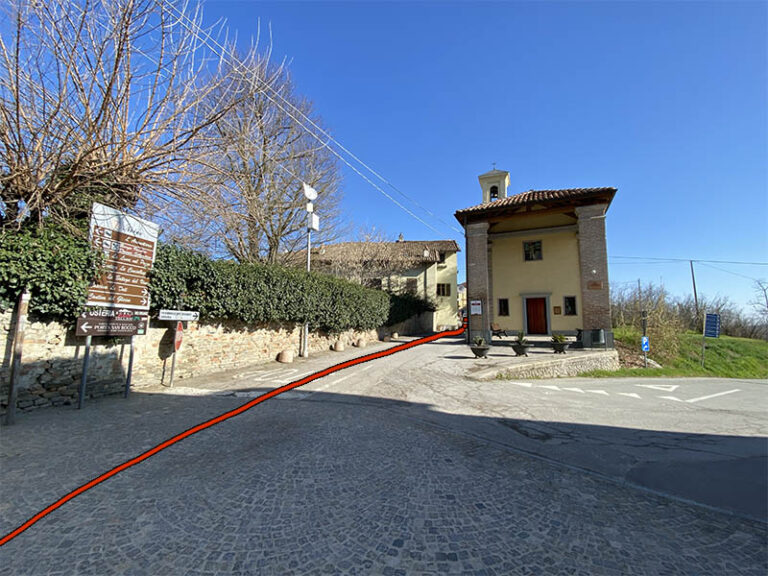
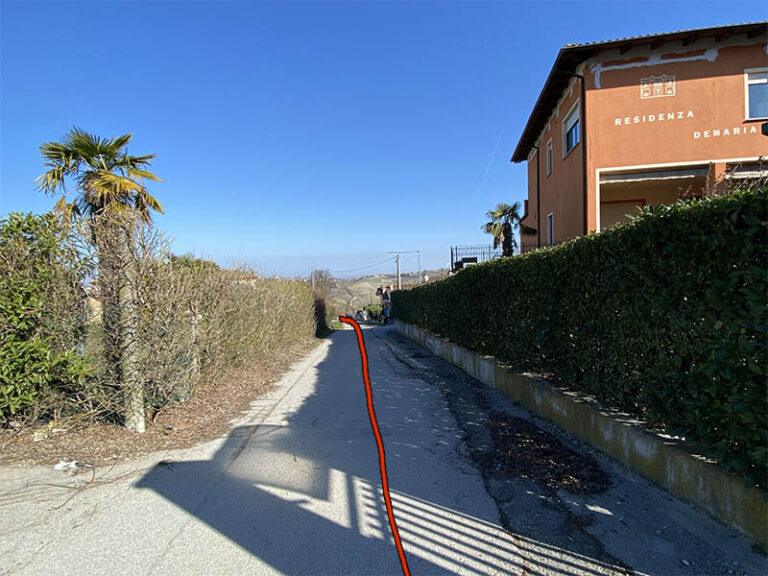
We are in the territory of the Langhe, but we are almost on the border line with the Roero.
We reach by car the village of Neive and the starting point of the hike, located in Via Giulio Cesare,
where it is possible to park the car in a clearing.
I will try to illustrate in as much detail as possible, with photographs and information, the first part of the route
of this loop tour, which, strangely enough, in the early stages has no signs, symbols, arrows or directions
that would allow simple orientation for those who are not familiar with the area.
From the small chapel of San Sebastiano (a tiny rural church erected to protect against the plague),
the asphalt road of Via Giulio Cesare starts, which we are going to follow in a northerly direction [photo A].
We pass first by houses, and then by a residence for the elderly that we will find
on our right [photo B].
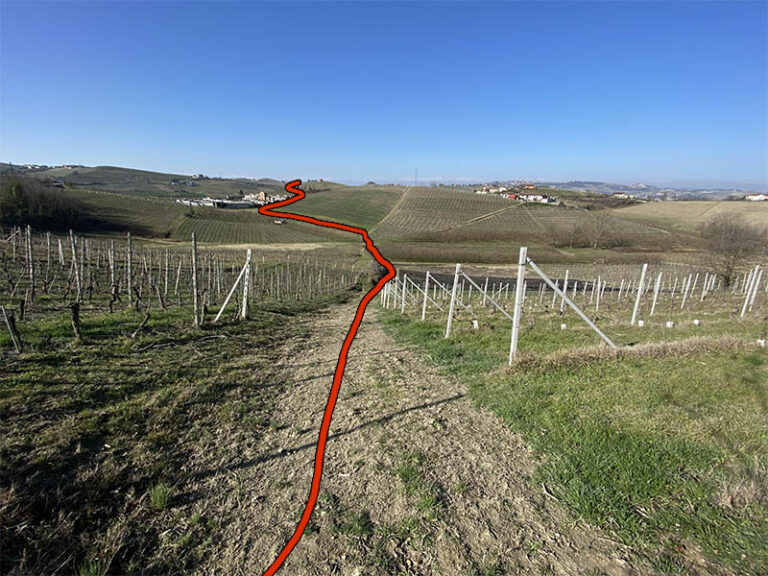
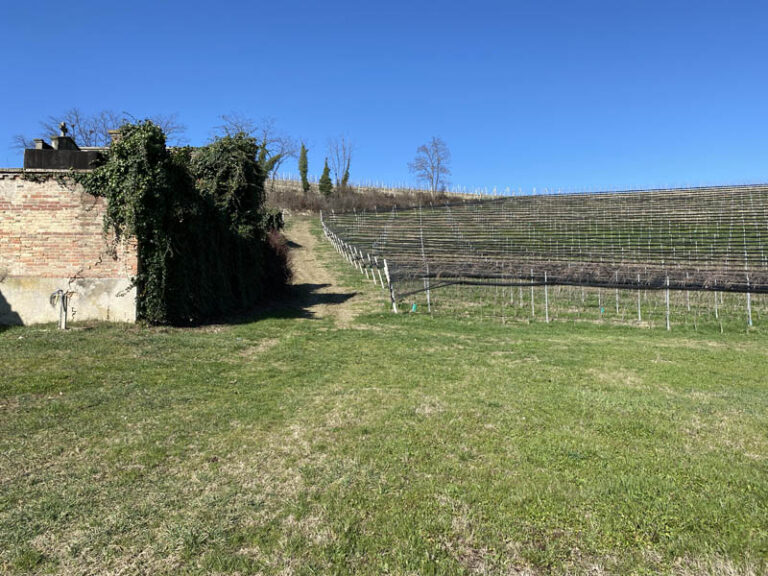
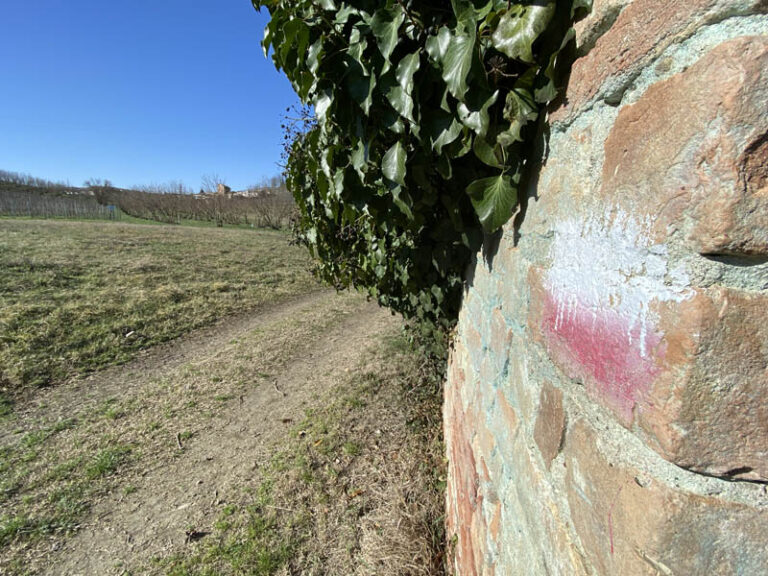
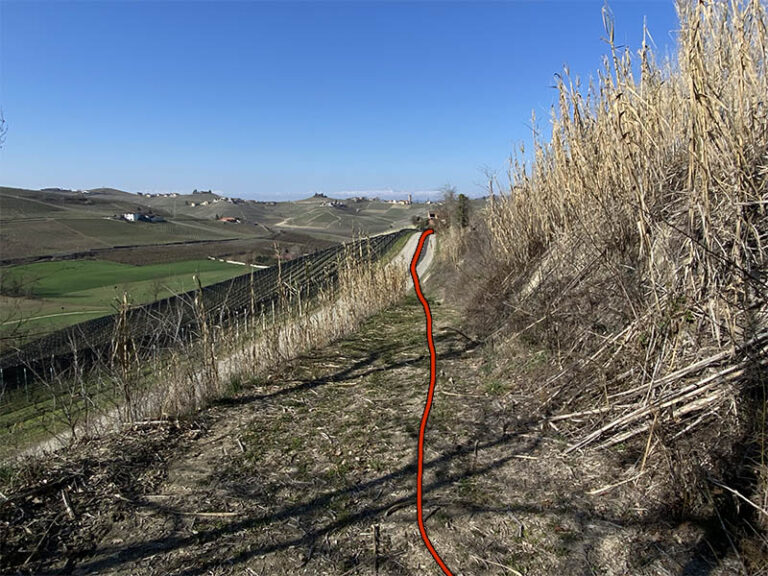
We continue on this paved road that soon becomes a dirt road, and will begin to descend among the vineyards,
where we will have before us a very open view of the hills that, with a sinuous course, disperse towards the Roero.
We descend the farm road along the vineyards moving to the left, going to lap the walls of the cemetery of Neive [photo C],
and then briefly ascend a farm road that will take us along a secondary paved road: via Crocetta [photo D].
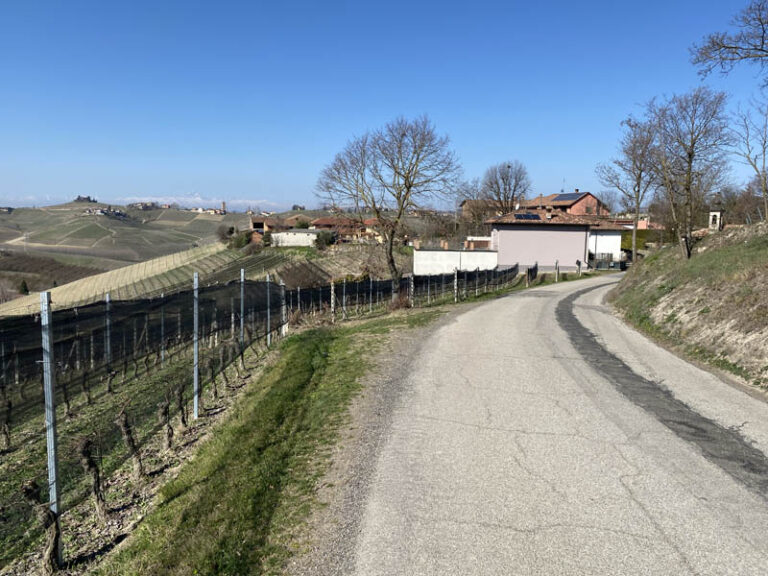
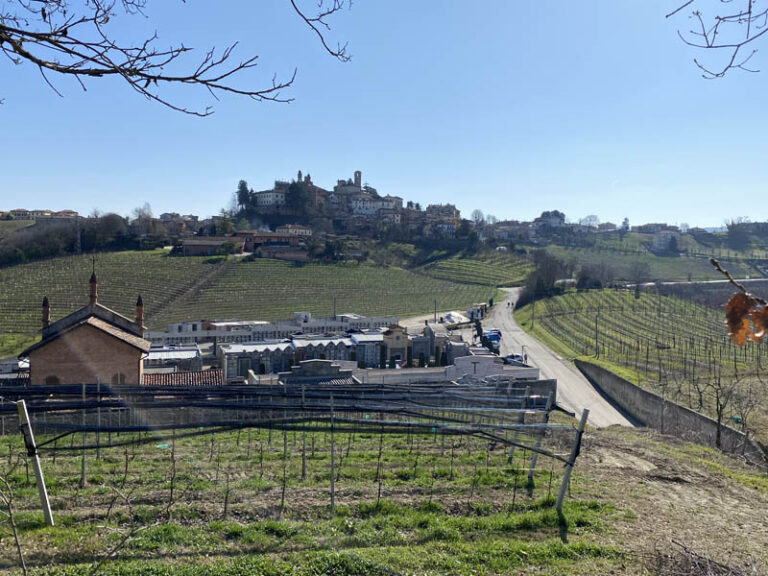
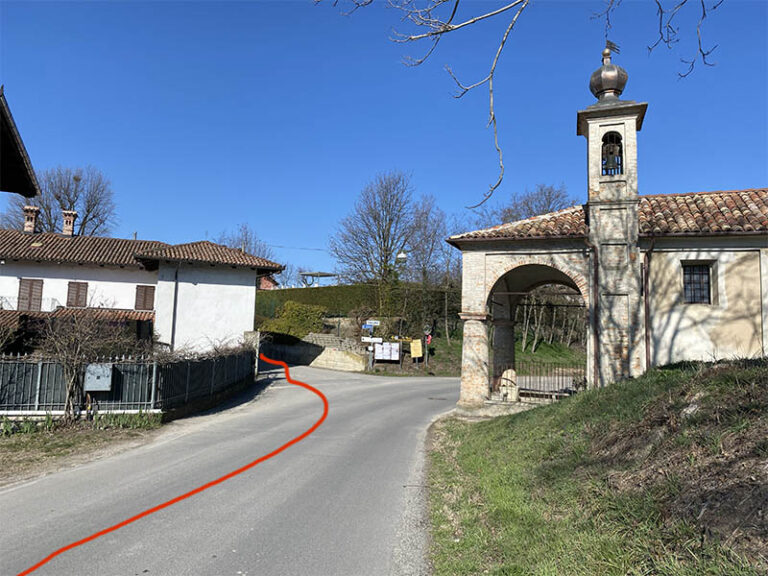
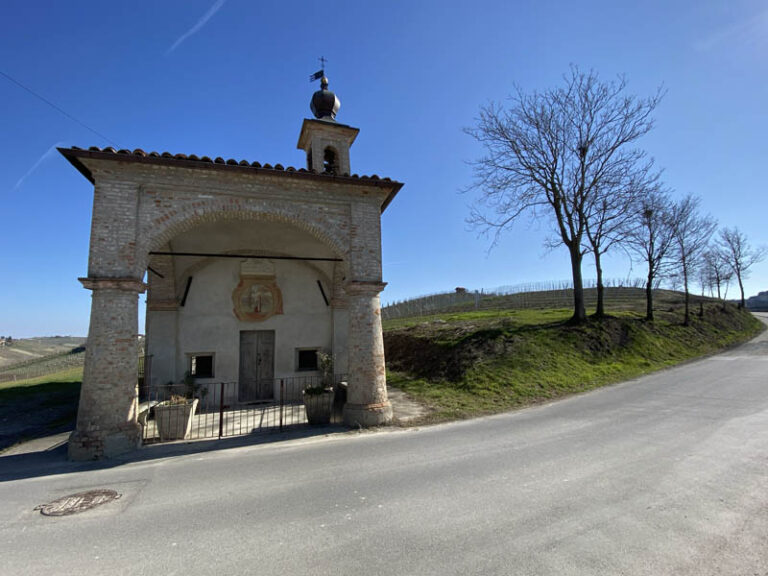
We pause for a moment to appreciate the view.
To our left are vineyards and large expanses of crops that rise and fall from the hills, in front of us on the horizon
we catch a glimpse of the tower of the village of Barbaresco (our destination) and “just behind” towers Monviso
with the entire chain of the Alps.
Behind us is the village of Neive, which we recently left.
The slightly downhill paved road takes us near a fork in the road.
On the right we find an ancient and small church, we need to keep left and continue entering the small
hamlet of Gallina [photo E].
Here we find one of the first “red and white” symbols confirming the correctness of the route taken.
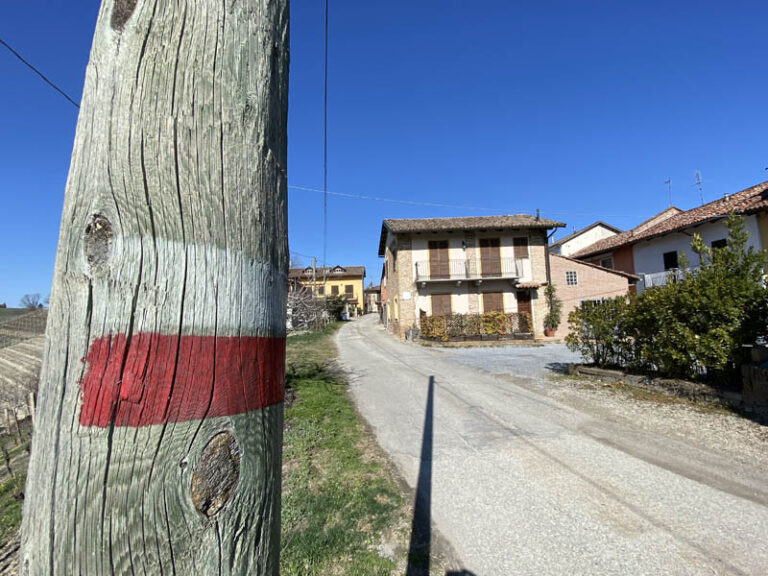
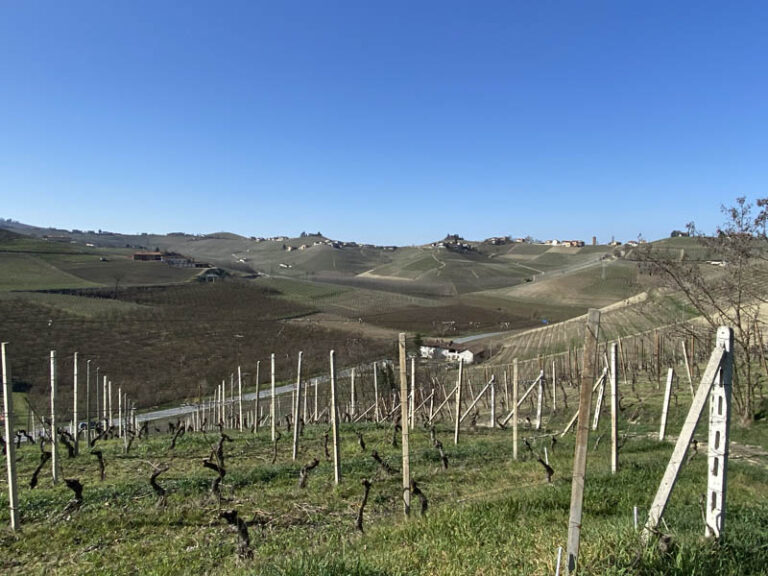
We continue on a secondary asphalt road, pleasant, not at all busy, that skirts the prestigious vineyards,
until we reach near the state road to Alba (via Tanaro), which we are going to cross [photo F] and where
we finally find the signs clearly indicating path n° 313.
This first part of the report, I have tried to detail in order for everyone to have a clear trail to follow, without running
into mistakes that would lead to missing the correct path.
In our opinion, in the Neive – Gallina section, it would be necessary to include clear signposts with arrows and markers,
which were completely absent when we passed through in the second week of March 2023.
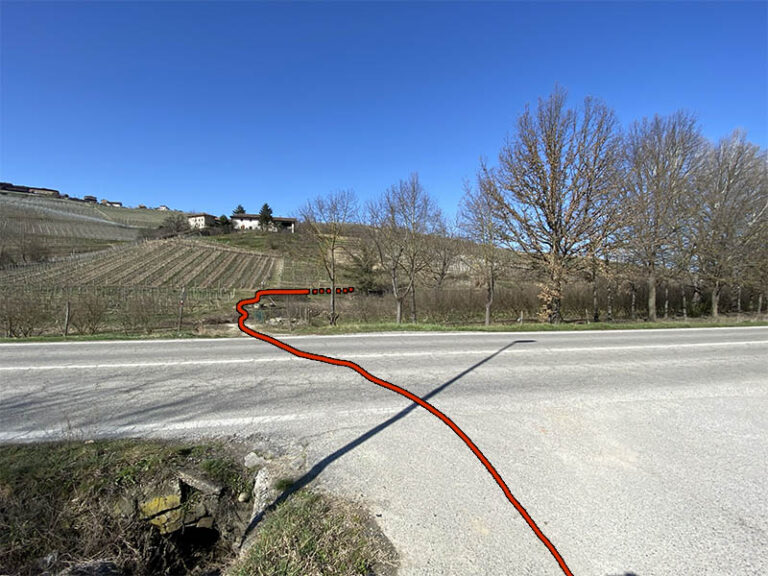
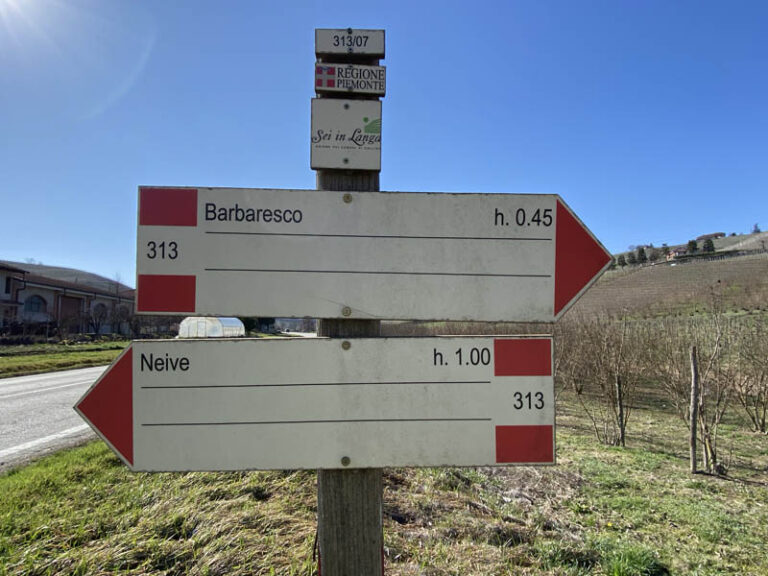
Having crossed the state road, we take a path that runs alongside a small canal.
We will then pass over a small wooden bridge and turn left shortly afterwards, continuing on a wider path that will
take us through vineyards that stretch both along the hillside and on the level side.
Still following this pleasant and relaxing farm road, we come near a concrete bridge, pass under it and come out
into “another world.”
This bridge, marks an “imaginary border”: in fact just after crossing it, we will find ourselves immersed in dense
hazelnut groves that lap the wide path.
Path that we walk for about 5 minutes and that ends in front of a large tree.
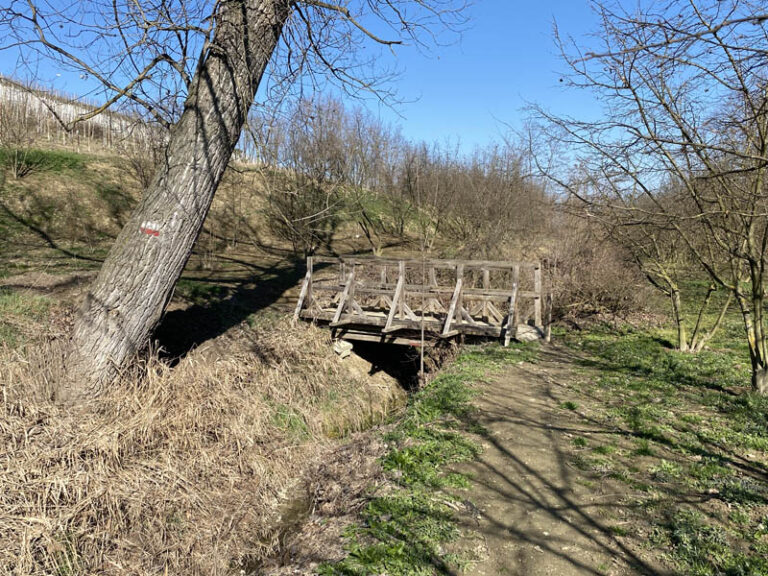
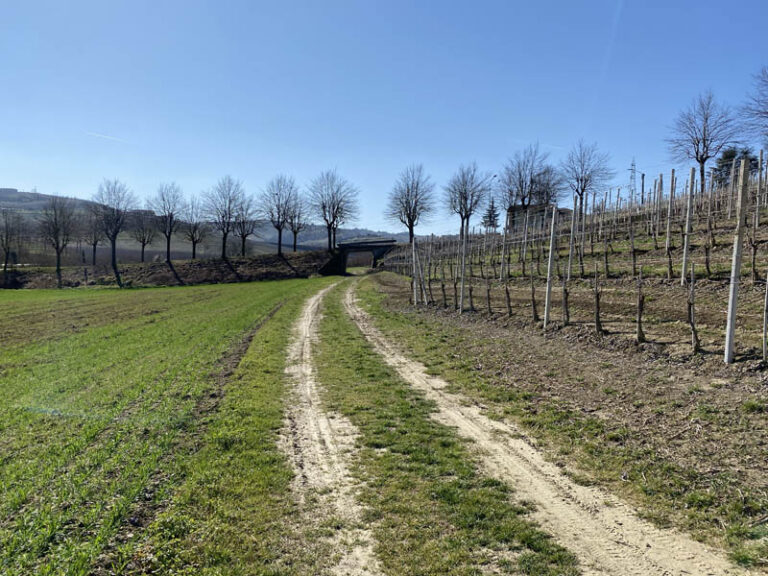
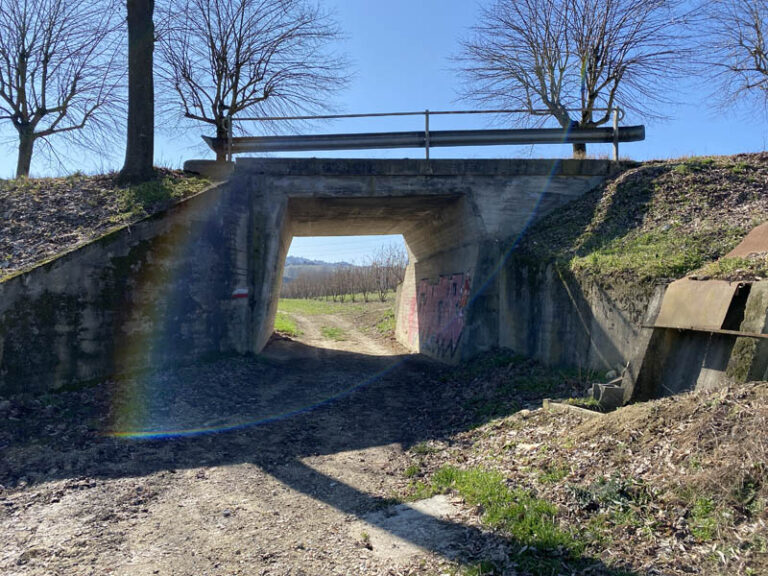
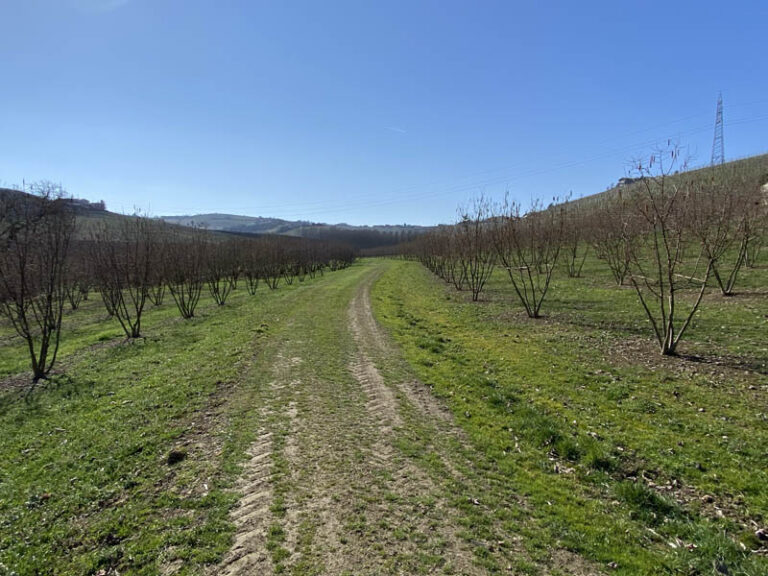
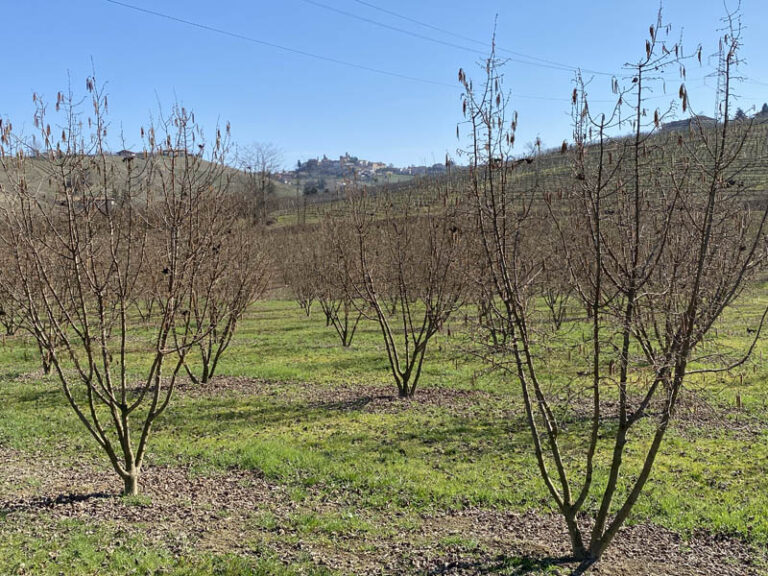
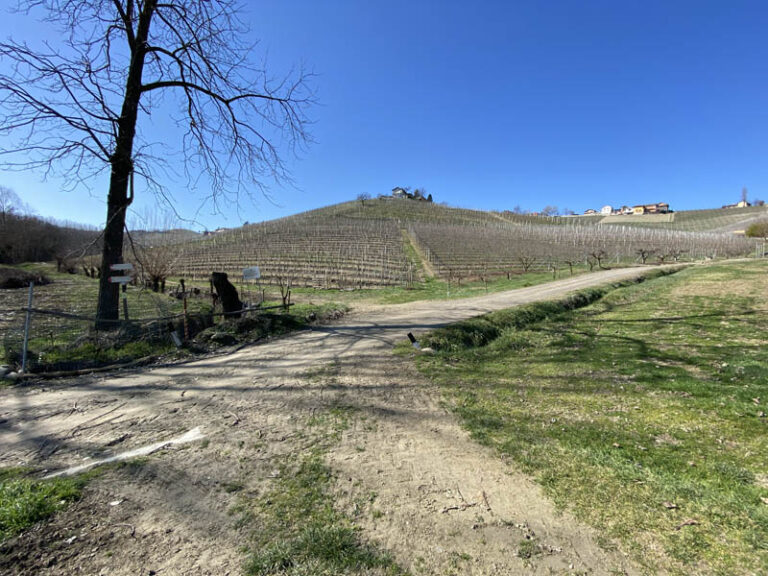
We follow the signs and turn right, going up again among the vineyards for about 15 minutes up a small hill,
until we come to the pleasant clearing called the “wayfarer’s rest,” which is on the left of the farm road we are traveling
and where a bench of the giants and 3 barrels have been placed, allowing us to climb on it easily.
Our advice is to make a stop at this place.
The giants’ bench was made by Cascina Munesteu, and it offers a magnificent view of part of the Langa hills facing
the village of Neive, which is clearly visible from here.
What peace, what silence, what tranquility.
One finds oneself isolated in a picturesque setting, surrounded by green vineyards and where time is marked only
by the shadows the sun draws on the ground.
The early March sun, with its warmth, makes this brief pause particularly pleasant, before resuming the journey
in the direction of the village of Barbaresco.
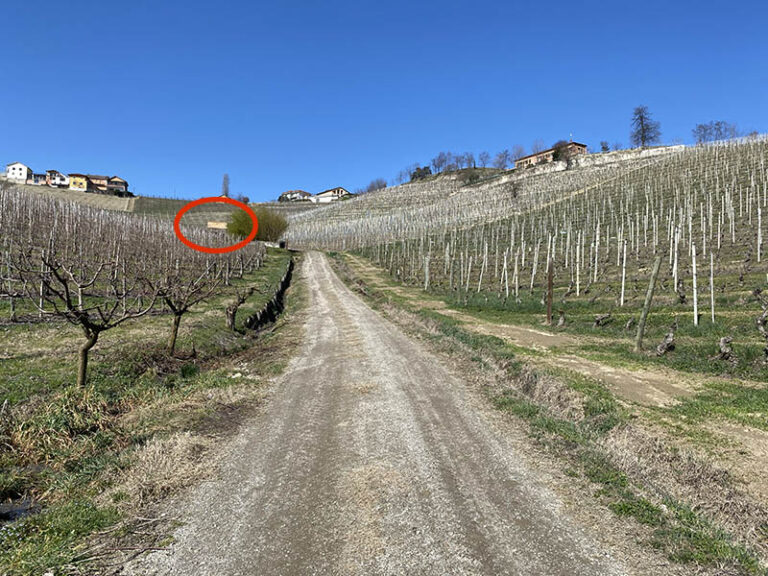
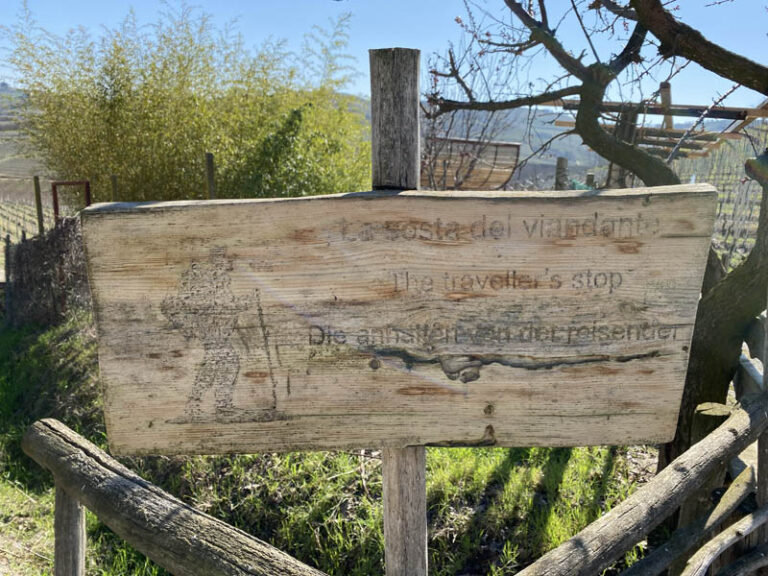
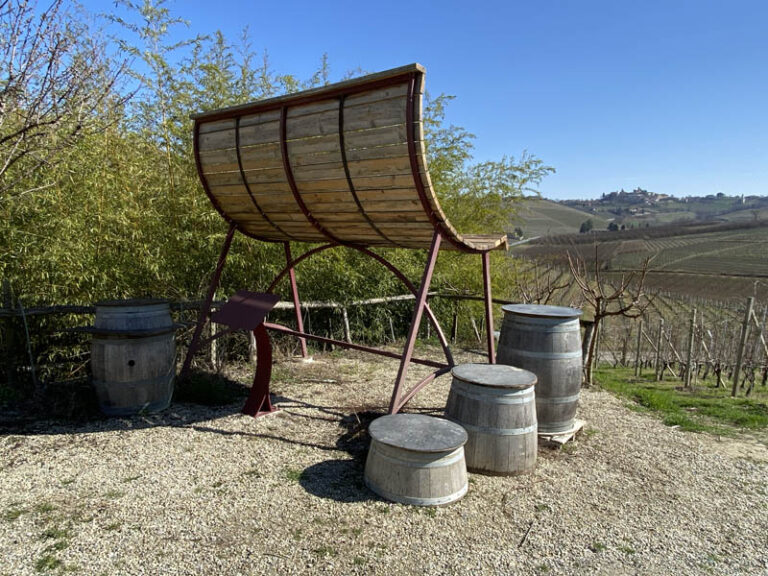
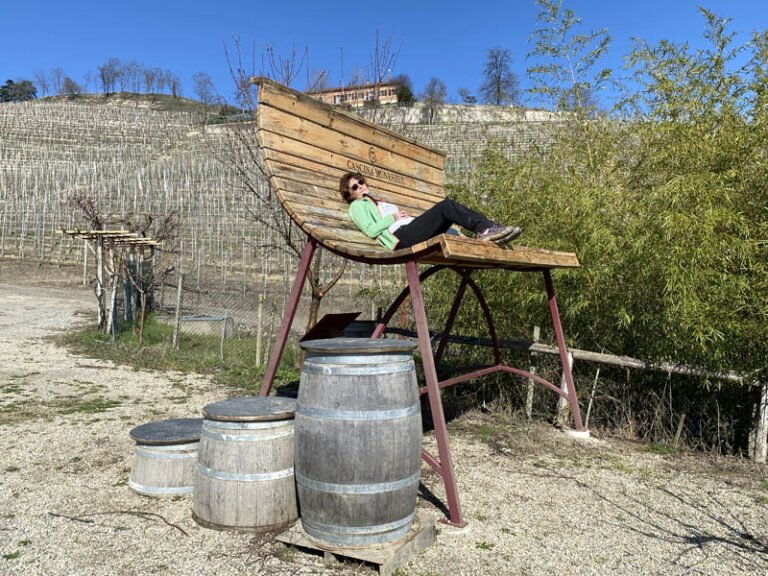
This small area called the “wayfarer’s stopover” is located about 3/4 of the way along the trail.
Next to us the newly bloomed flowers of the fruit trees delight us with their burgundy, white and yellow colors that
contrast with the blue of the sky.
“Confetti of colors” that further validate even in spring, as well as in autumn, the beauty of these places.
One writing reminds us that the wine produced from these extraordinary lands, “is not only art, it is not only passion,
but it is above all love.”
Lands that are not always so hospitable, that one must know how to work them with tenacity, perseverance and a lot
of commitment, following the traditions and ancient knowledge of those who have dedicated a lifetime to the study
and care of the vineyards.
It is from here, from these places, that wine is born that does not disappoint the expectations and the most
demanding glasses of those who love the wines of the Langhe, particularly represented by Barbera,
Nebbiolo and Dolcetto.
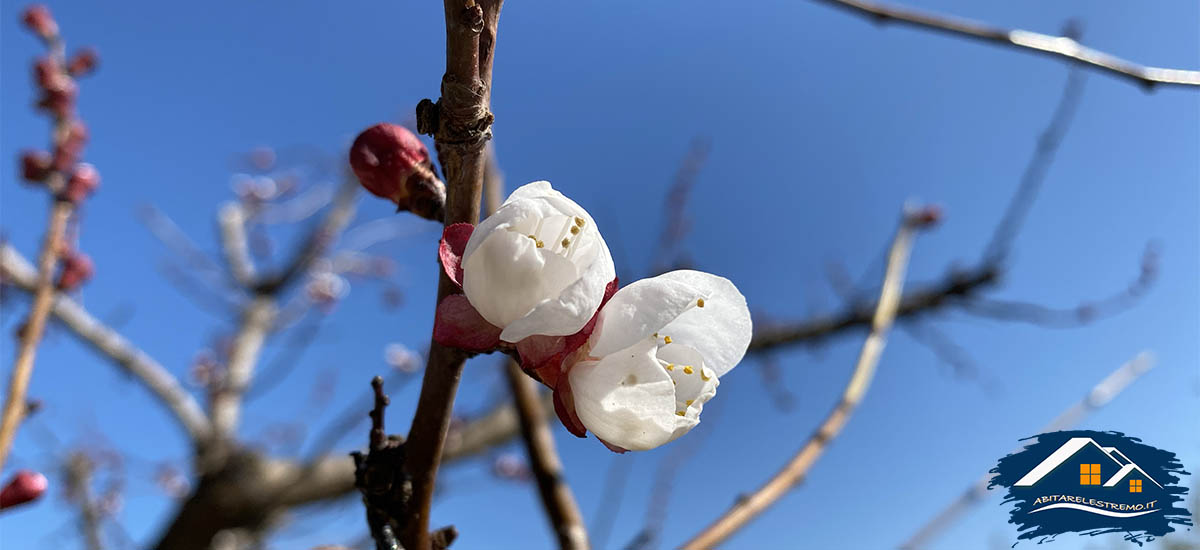
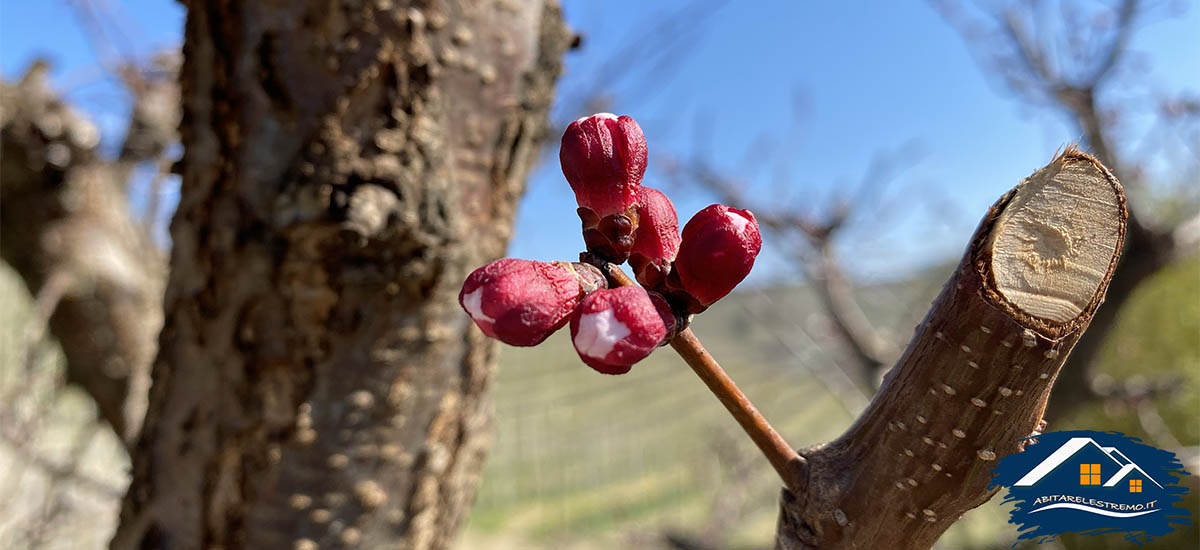
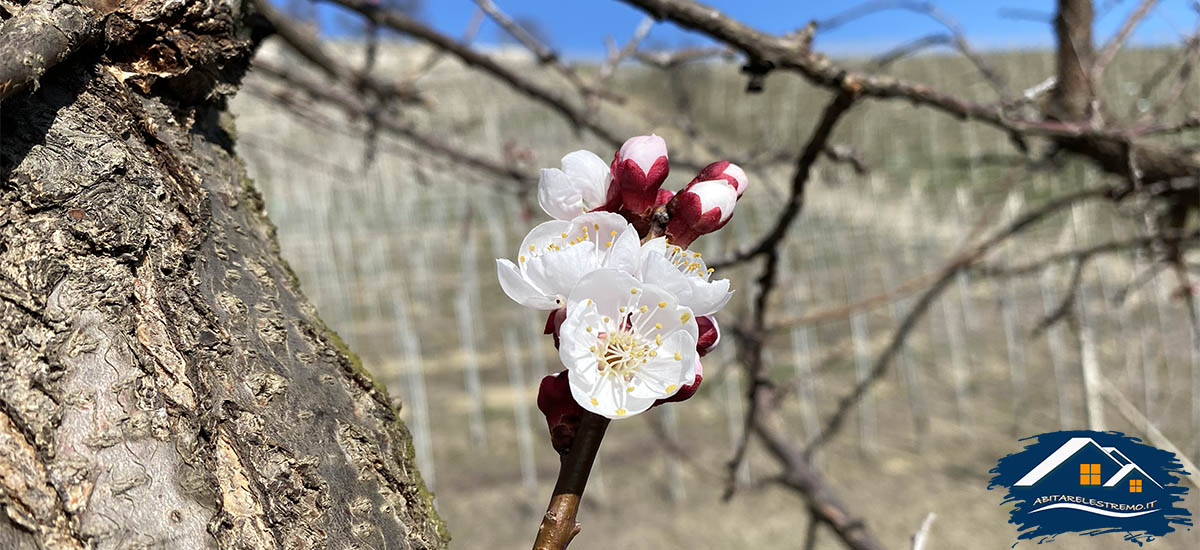
We set out on this farm road that gently climbs a hill, with curves first to the right, and then to the left along
a path that is never tiring, totally immersed in the vineyards.
Almost suddenly, shortly after arriving at the top of the hill, the village of Barbaresco materializes before our eyes,
well recognizable also thanks to its large tower on which we will soon climb.
Arriving at the top of the hill, we cross the road going to take via Domizio Cavazza, which still passes by a few last
vineyards that we find on our left, and a series of residential houses that we find on our right.
We walk along via Domizio Cavazza until we cross via Torino on the right, which runs through the village of Barbaresco,
made up of old buildings, stalls with typical products, and wineries where you can buy the wine produced in the area.
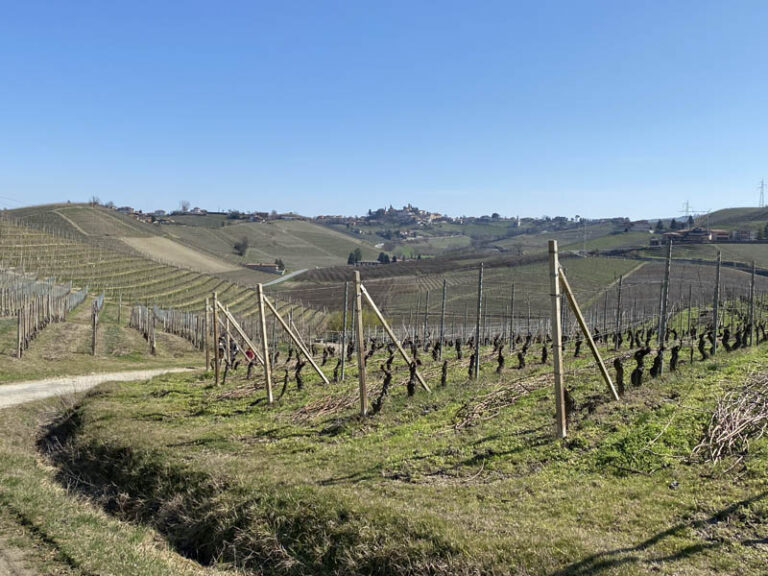
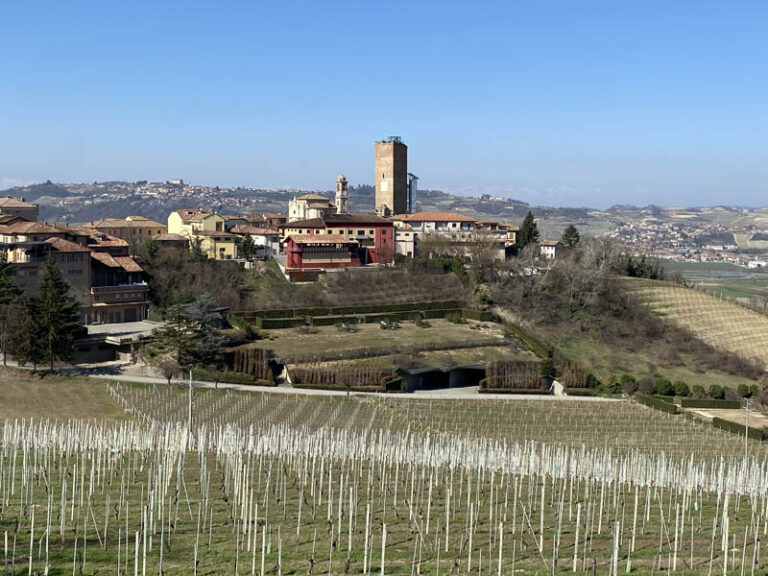
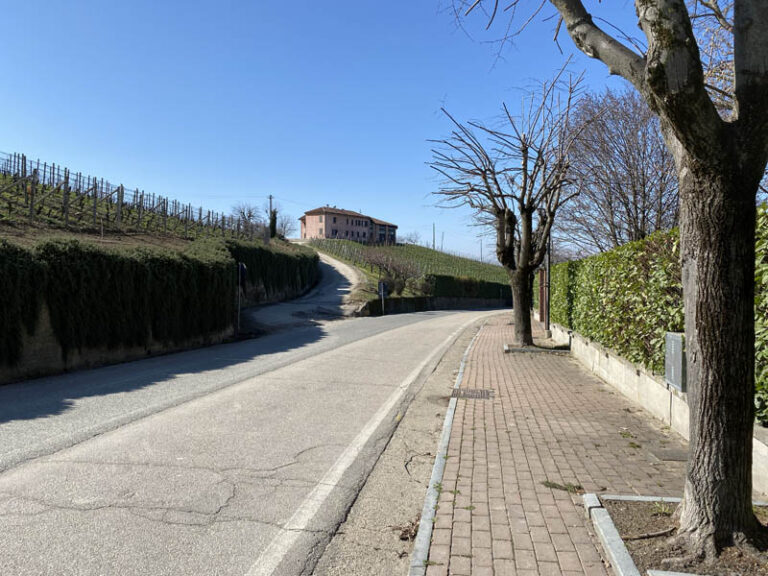
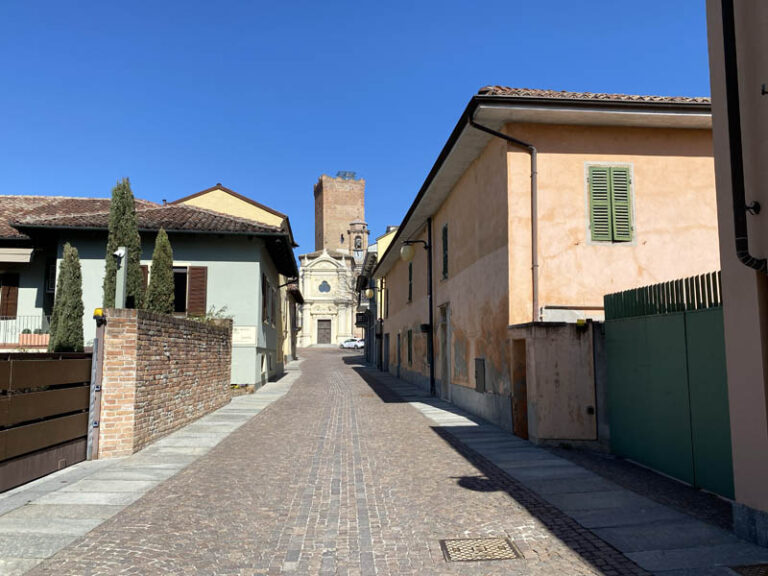
In a short time, Via Torino takes us all the way to the vicinity of the tower.
At 36 meters high, the medieval tower of Barbaresco is the largest and most massive in Piedmont, and was built
around the year 1000 to defend the town from the Saracens.
Located toward the end of the village, it served as a lookout for potential enemies in the past.
It was probably part of a system of towers built along the Tanaro River, all with the function of “sighting”.
The Barbaresco Tower, now fully restored, has been open to the public since June 1, 2015, but for many years it was
reduced to ruins, and is what remains of a system of fortifications and a castle of which, unfortunately,
in our days, no trace remains.
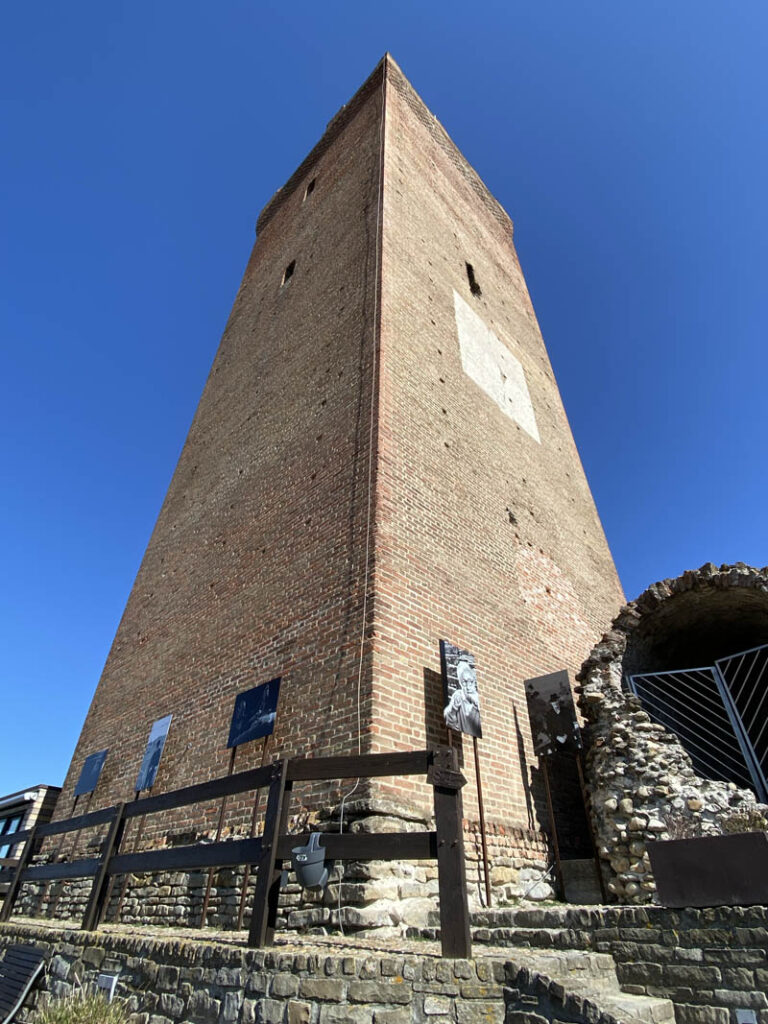
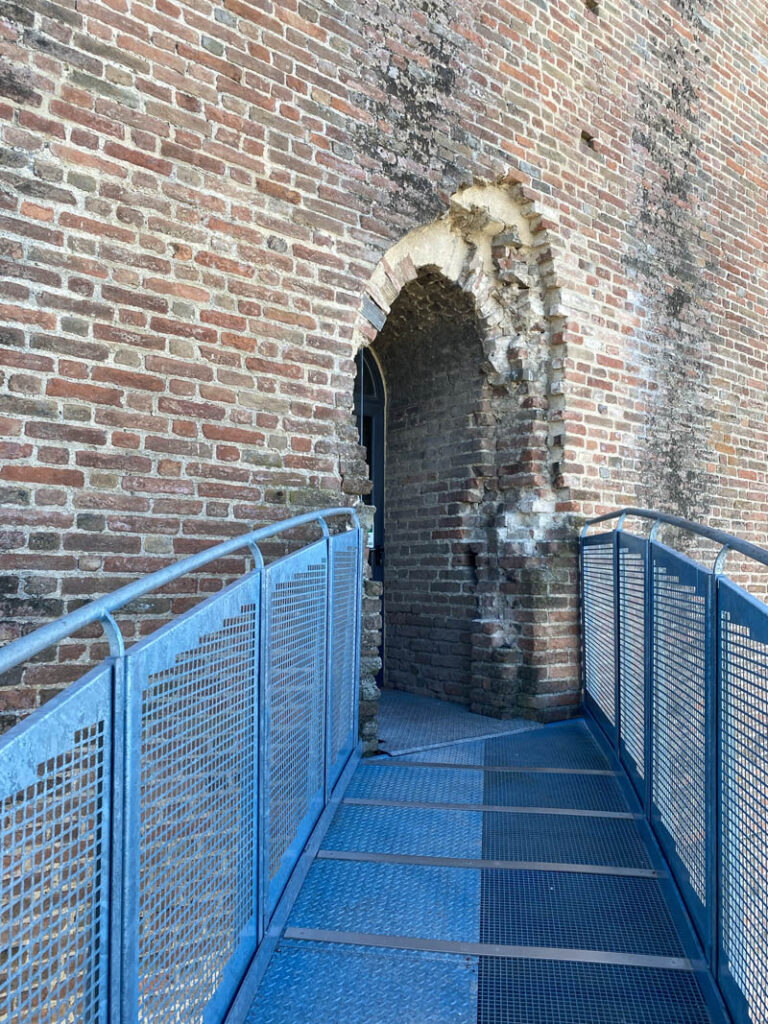
Before entering and going up the tower to visit it, we stop to look at some significant photos in black and white.
They are representations of the hard and demanding work that requires the cultivation and subsequent production of wine.
An art, an experience handed down from generation to generation, where the “old men” have always been a resource
of information and professional secrets.
Access to the Barbaresco Tower is via a walkway and an initial short elevator ride to the entrance located 13 meters
above the ground!!!
There is the purchase of a ticket for a few euros to climb the tower, which is really worth spending to fully
enjoy the crazy view.
Our advice is to walk up the entire tower, embellished with crystal and steel inserts that allow a truly unique view
inside the tower.
We climb three levels before reaching the top.
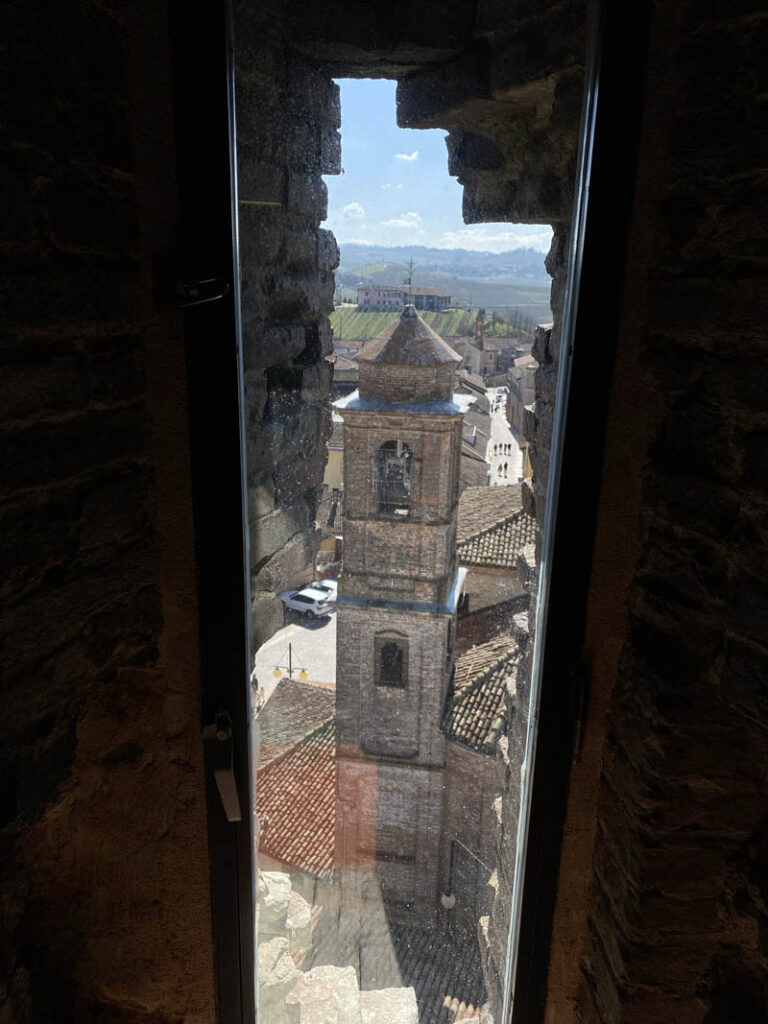
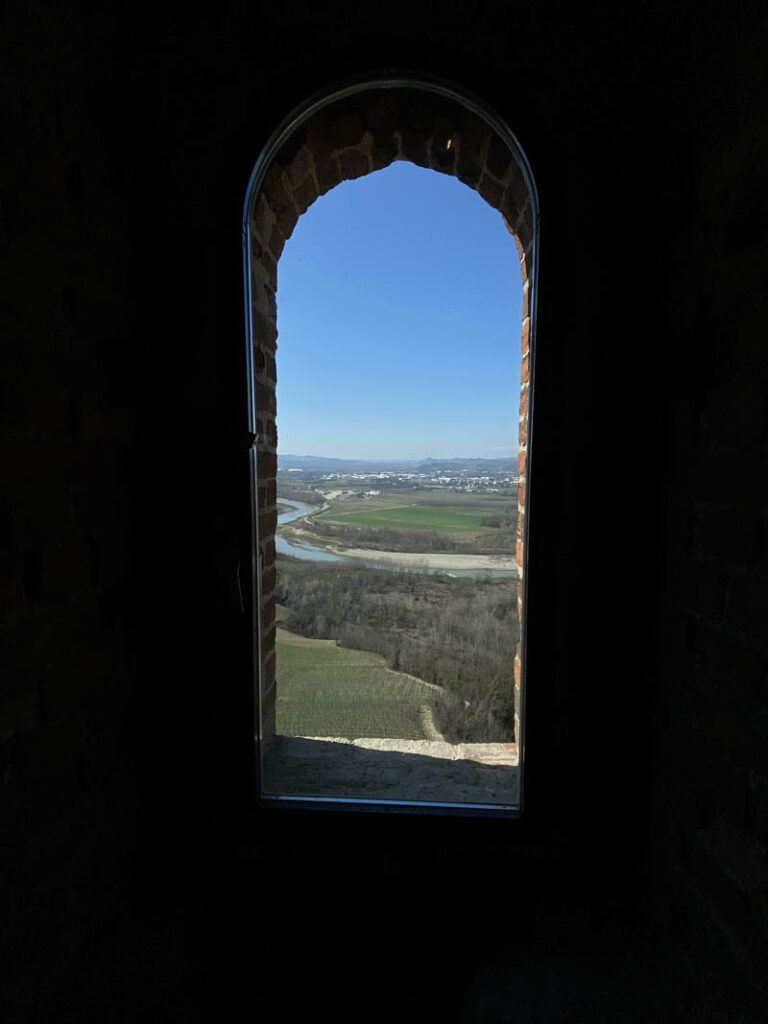
On the first level, it is possible to delve into and learn through a multimedia system, the stories of the men who helped
present and bring Barbaresco wine to the whole world.
We will find the various indications of the grapes produced in the area and their place in gastronomy.
On the second level, as you go up, slits appear from which you begin to see from above the village of Barbaresco,
which appears in all its splendor.
In some of the compartments located inside the tower, water was once stored, to ensure a certain autonomy
for those who lived there.
The interior walls are formed by thousands of bricks laid one on top of the other.
The third level is the panoramic terrace, from which there is a truly unique view of the whole area.
I provide below a map, to try to give you an idea of the vastness of the panorama that we will have before our eyes.
A crazy view that, from its 36-meter height, sweeps from the village of Barbaresco to the hills of the Langhe,
from the Tanaro Valley to the entire chain of the Alps with Monviso and Monte Rosa, from the hills of the Roero,
to the Asti area, and then on to the Alessandria area: an endless spectacle.
We stop for quite some time to observe, today on a particularly clear day a panorama of such vast proportions,
almost without boundaries.
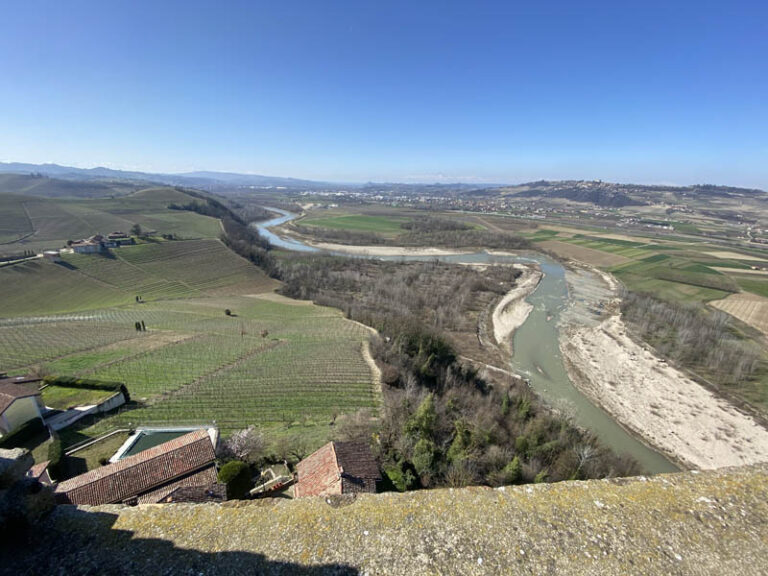
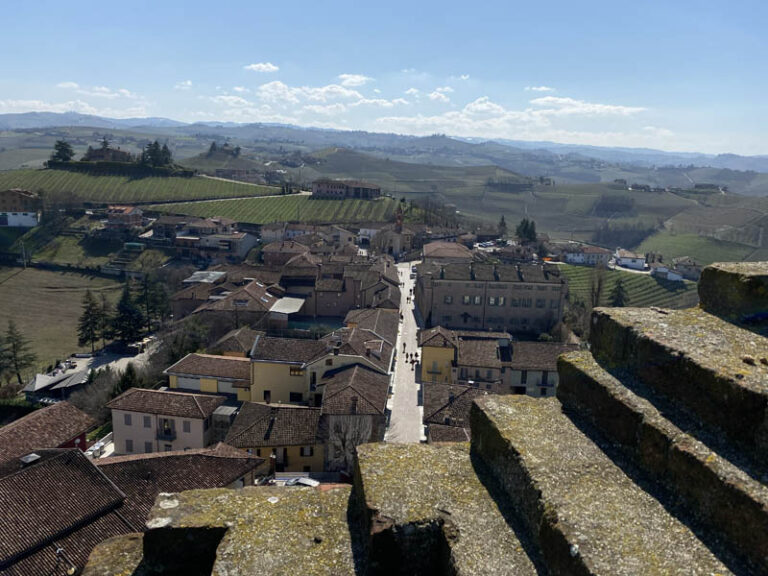
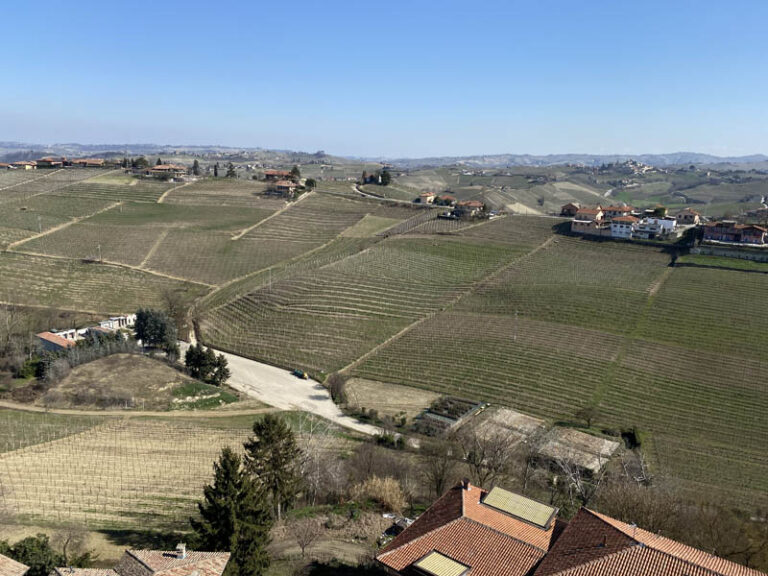
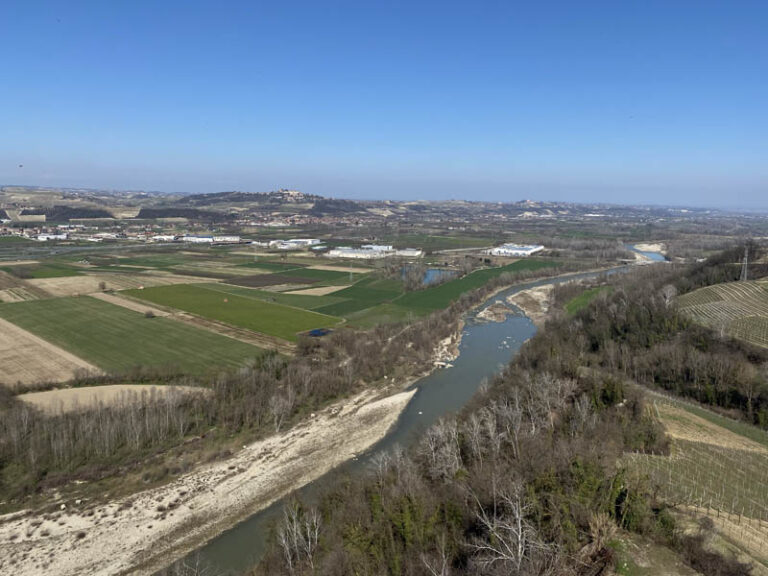
After a tour through the streets of this quaint village, we resume the return route, which will be only part of the one
we faced on the way out.
We retrace our steps backwards along Via Torino and then Via Domizio Cavazza, and then return to the poderale
that will take us past the giants’ bench made by the Cascina Munesteu of the “wayfarer’s rest” area.
We descend past the giants’ bench, but when we come near a dense poplar forest, instead of turning
left (from where we came in the morning), we turn right skirting the forest and following the wide farmstead marked
by signs in the area.
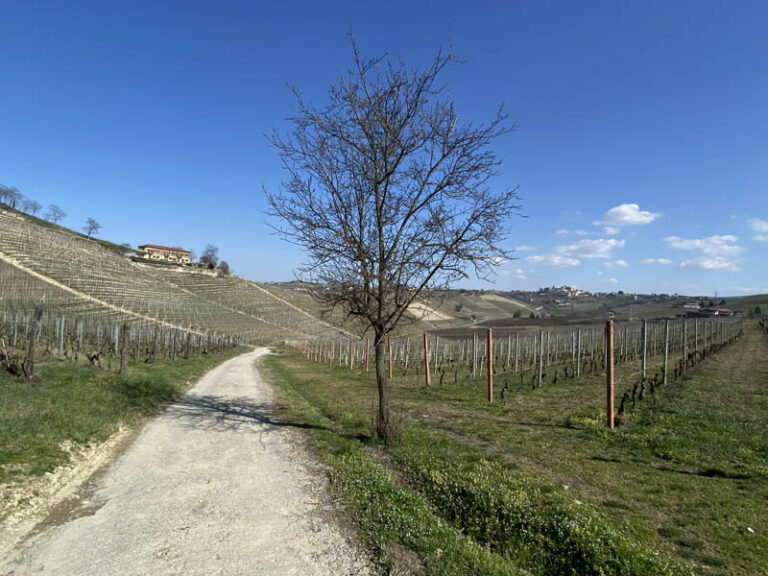
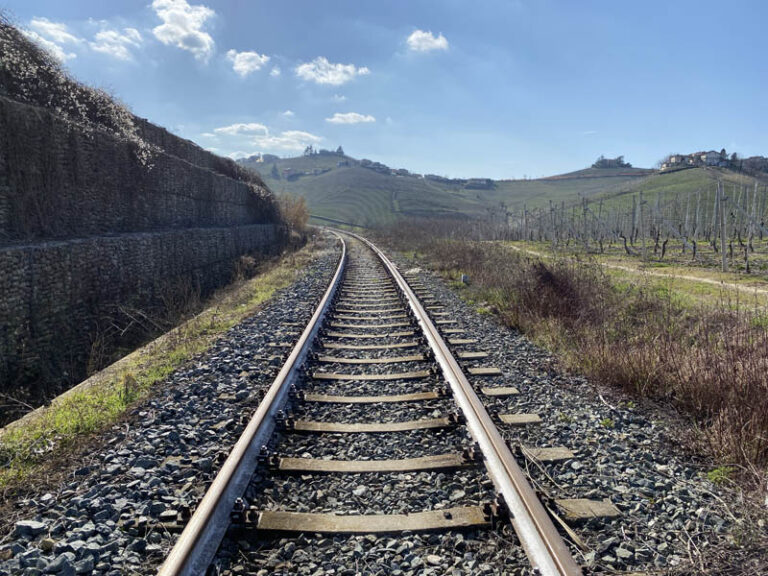
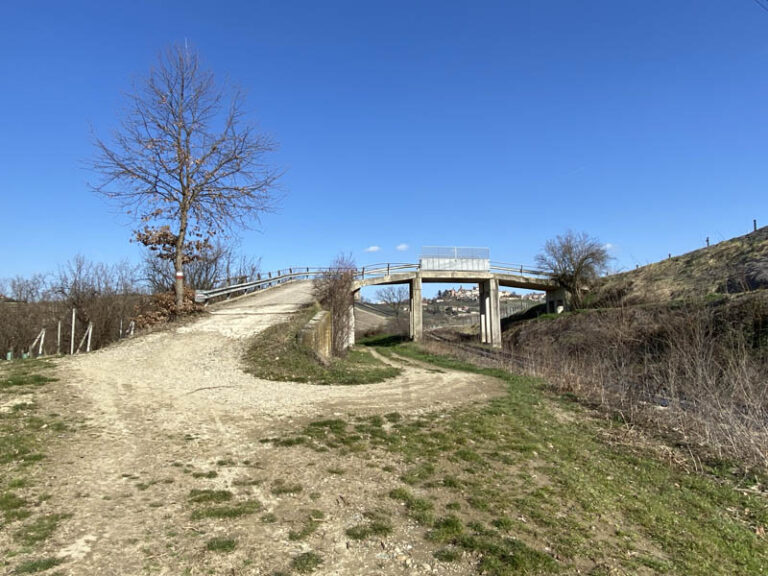
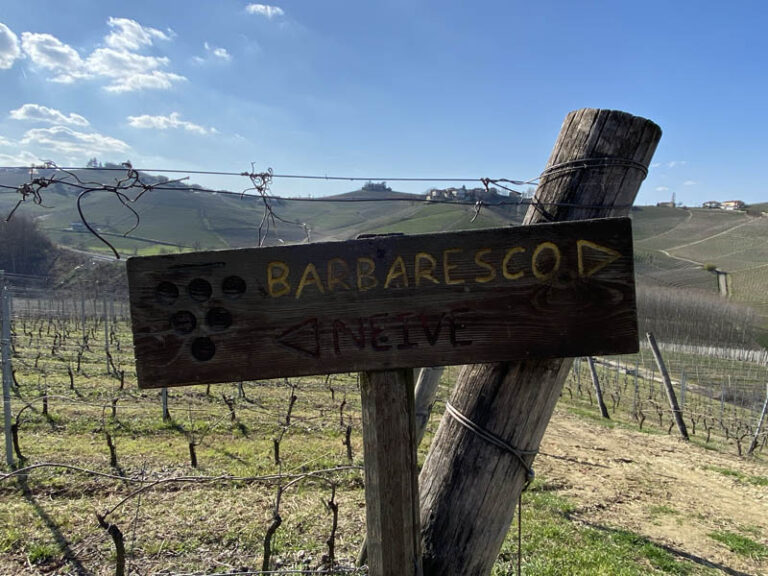
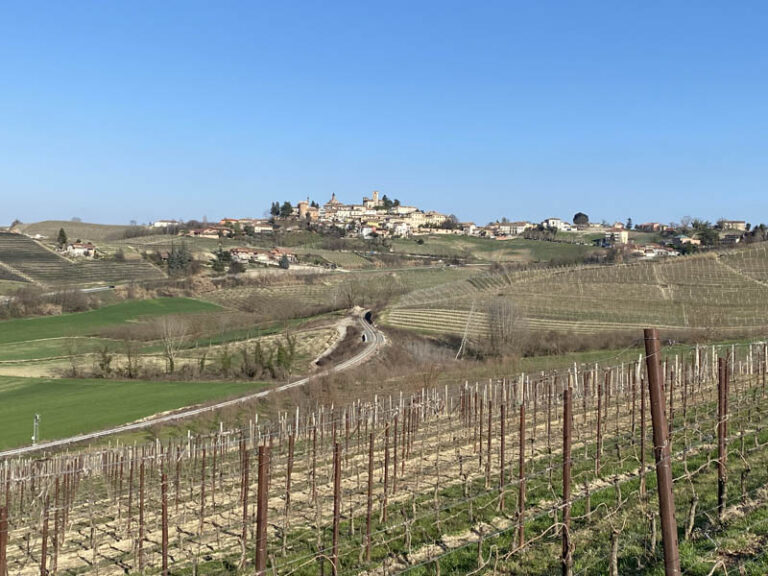
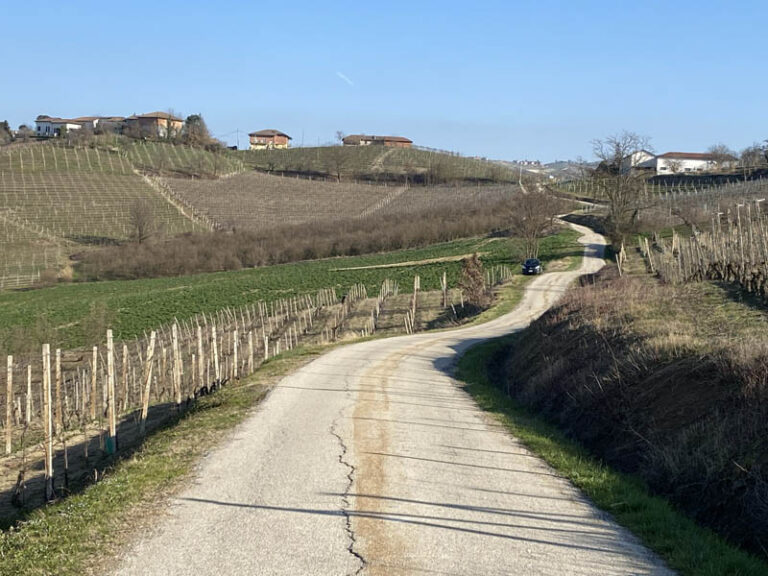
Going around a vineyard, one comes to the vicinity of the tracks of the Bra – Nizza Monferrato railway line,
built back in 1865 and now sadly abandoned due to “bureaucratic problems,” which, it seems,
prevent its restoration.
This is a pity, because this work could be enhanced and used as a transportation service.
It could be turned into a tourist attraction with the passage of ancient convoys, which would go through picturesque
areas, interspersed with various stops leading to various points of ascent of the many hiking trails in the area.
After skirting the tracks for a short distance, we go up a concrete bridge on the right, relying on the red and white
markers and where we later find a wooden sign with a bunch of grapes drawn on it and directions:
right toward Barbaresco and left toward Neive.
We continue on a narrow farm road that meanders between vineyards.
We thus arrive in the locality of Principe and after a bend here the village of Neive appears in the distance.
We cross the hamlet of Gaia with a few more passages that alternate between vineyards and dirt roads.
We then enter Neive and reach Via Giulio Cesare to find the car parked in the morning.
This closes a loop tour that joins two really very very beautiful villages.
A scenic route, with a continuous alternation of ups and downs in country settings, surrounded by crops and
vineyards, all through the prestigious hills of the Langhe.
Thrilled to have experienced and documented this new hike, our thoughts are already racing toward our
next destination.
Thank you for coming this far in reading this new page of life, in an environment that believe me is truly worth
frequenting, discovering hill after hill.
You will never be disappointed, on the contrary, you will remain in love and that will be the (pleasant) problem.
Report and photographs by: Michele Giordano and Andreina Baj
Official translator of abitarelestremo: Andreina Baj
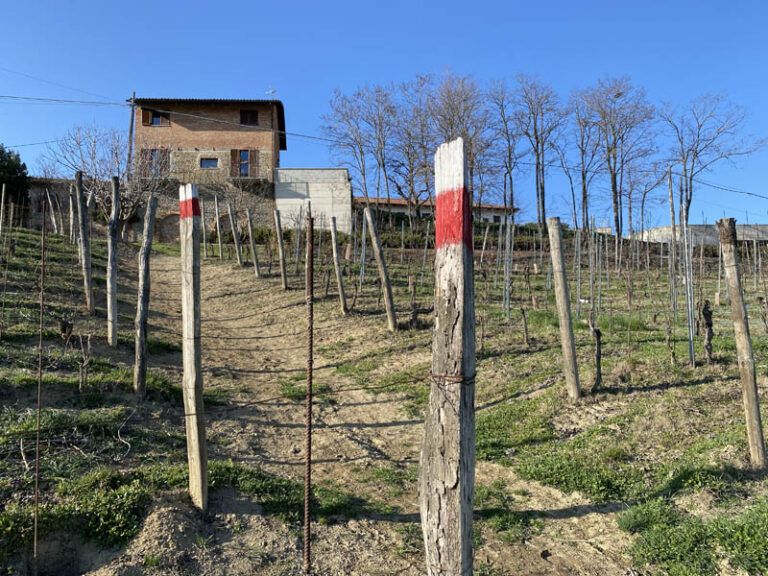
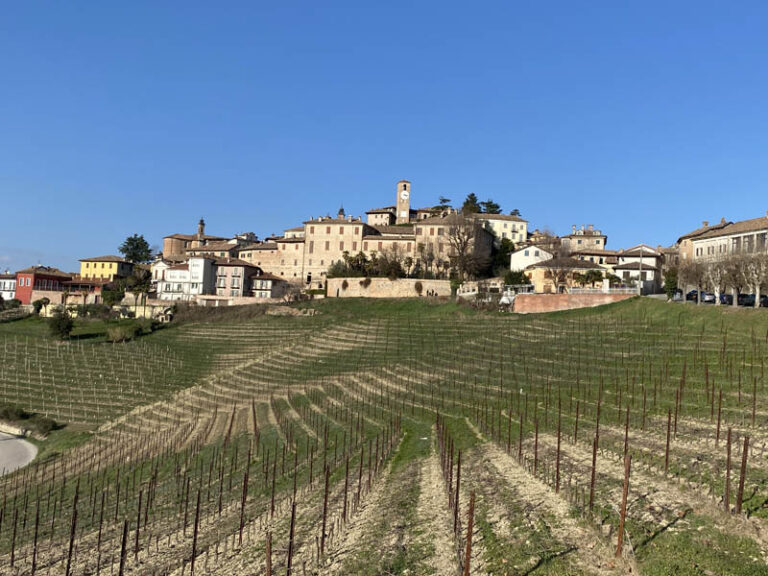
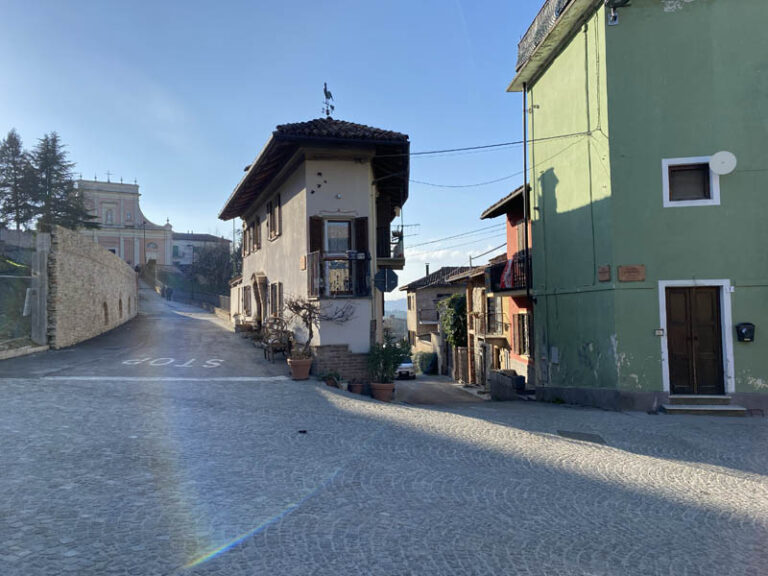
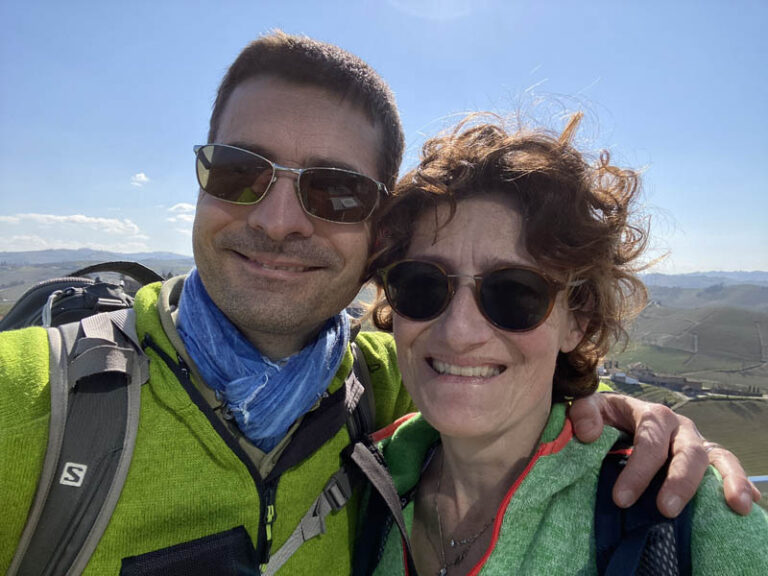
Notes: rewarding loop trekking, which through paths, back roads and rammed-earth farms, joins two historic villages
of these places.
Passages between the ever-present vineyards and hazelnut cultivations will cheer a route formed by continuous ups
and downs, never tiring, with a totally open 360° view and after each hillock, you discover something more.
Very welcome is the bench of giants made by Cascina Munesteu, laid in a perfect place both as a view, as an
environment, and as ease in reaching it.
The climb up the Barbaresco tower is (trust me), mandatory if you are in the area, because you will admire even
more the beauty of these places.
To be improved are the directions and signage especially in the initial part of the route, when from Neive you are
looking for the path that leads to Barbaresco.
Such beautiful places, they deserve precise directions, because they will appeal mostly to those who are not familiar
with the area: everything else is magic.

